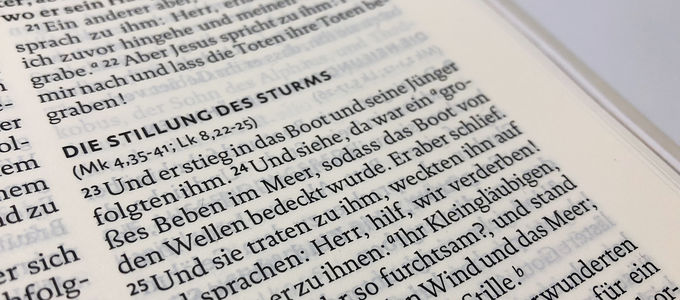
Martin Luther left his mark on both church theology and the German language with his translation of the Bible. A revised edition appeared on the 500th anniversary of the Reformation. Starting in 2019, the 2017 Luther translation will be the official German-language Bible of the New Apostolic Church.
The ministers in the German-speaking congregations will have to make an adjustment in their sermons: starting on 1 January 2019, they will be using a new Bible translation. However, the changes compared to its predecessor—the 1984 Luther translation—appear rather marginal at first: there are some changes in punctuation and substitutions of individual words, but there are also individual verses that have been completely retranslated.
However, the German Bible Society—the ultimate authority for all Luther translations—offers the following account: roughly 40 per cent of the 2017 translation is actually distinct from the text of the 1984 Luther translation. The distribution of these changes is varied. In the Apocryphal books of the Scripture, for example, 3,700 verses out of a total of 4,400 verses have been changed, which amounts to 80 percent.
By comparison, the Old and New Testaments have only had to endure some gentle changes: of the approximately 31,000 verses of the Old Testament, only 12,000 verses—just under 40 per cent—have been revised. In total, the 2017 Luther translation exhibits nearly 16,000 verses diverging from the 1984 edition. According to experts, it is more precise—because it has been more accurately translated from the original text—and it is easier for the reading public of today to understand.
While the “storm on the sea” from the 1984 translation now appears as a “great quake” in the 2017 translation—the original text uses the term seismos, which does rather suggest a seaquake, after all—the expression “weeping and gnashing of teeth”, one of Luther’s more familiar linguistic creations, will remain the same. This has been met with relief by proponents of Luther’s famous idiom. After all, they believe, the Luther Bible is the very epitome of powerful language use. Naturally it contains many everyday concepts, but every now and then there is a flash of something special, something sacred. Among other things, this speaks for the linguistic genius of the most famous German theologian.
Those who wish to learn more about these text modulations can find a little foretaste on the website of the German Bible Society.
Luther’s beautiful text
Among the many German translations of the Bible, it would be inconceivable to do away with the Luther translation. It offers a competent, vivid treatment of the original texts. Luther’s translations have been used since time immemorial in divine services in the German-speaking regions of the New Apostolic Church. The 1912 Luther translation was in use for decades, and the 1984 version has been the standard since 2001. The Catechism, all doctrinal texts, and all educational materials of the Church in the German language quote from the Luther translation. For this reason alone, it would be out of the question to switch to a completely different translation.
This is a point on which the District Apostles of Europe are in agreement. At their last conference at the start of November, they were exhaustively advised on the subject, and ultimately passed a resolution to stay with Luther, but to adopt the 2017 Luther translation as of 1 January 2019. This will then become the official Bible in all German-speaking divine services.
Reasons for change
There are several reasons for this change. For one thing, the German Bible Society will gradually be removing the 1984 version from the shelves. The only edition that will remain is the so-called standard Bible. Reprints of the other versions will not be available. However, the New Apostolic Church makes use of several Bible editions: in addition to the standard Bible, there is also the altar Bible, the pocket edition, the student Bible, and even a Bible which is presented to couples at their wedding. In order to maintain the whole package going forward, the new edition will be needed.
In addition, the adaptations to the content also constitute an important reason behind the decision for change. In general, the new translation is closer to the original texts, while at the same time adhering to traditional German, albeit adapted to modern language. Bischoff Publishers is currently negotiating the purchase of this edition with the German Bible Society. The publishing house will not only incorporate the new Bibles into its product range, but will also produce versions with special covers for the New Apostolic Church.
Luther has left his mark
In the German-speaking countries, the year 2017 was a memorial year for the Reformation, which was ushered in 500 years ago in the Thuringian city of Wittenberg. At that time, the young Augustine monk Martin Luther was said to have nailed his 95 theses to the castle church—a historical date in collective human education.
In 1521–1522, Martin Luther—who had by then become a persecuted dissident—made use of his involuntary stay at the Wartburg near Eisenach to translate the New Testament from Greek into German in the record time of only ten weeks. Twelve years later, the entire Bible was published in his translation. Luther continued his efforts to perfect it until the end of his life.
Photo: Oliver Rütten




